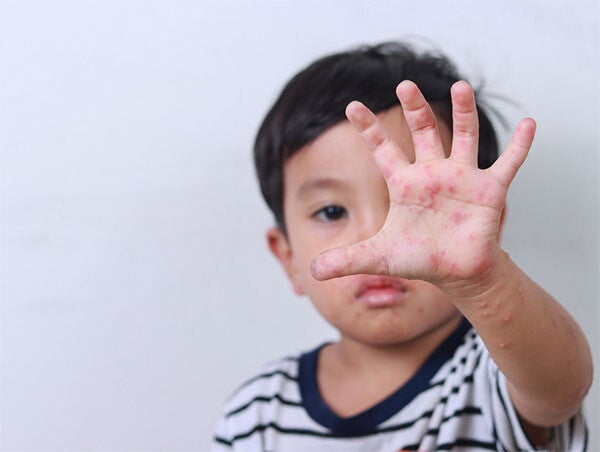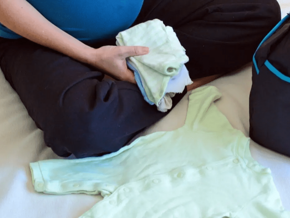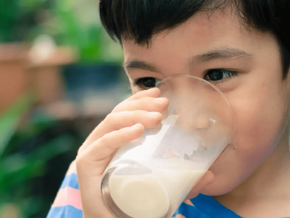
Singaw or Hand, Foot, and Mouth Disease Symptom? When to Call the Doctor
Your mind races because your little one has woken up and is not feeling well. They seem to have sniffles, scratchy throat, singaw, or all three. You tick off common diseases in your head, but are hand, foot, and mouth disease symptoms on your list?
Hand, foot, and mouth disease (HFMD) might not be the first thing that comes to mind, but it should be because kids are most at risk for this viral illness. The Philippines recorded 7,598 HFMD cases from January to February 2025. This figure is nearly three times higher than the 2,665 cases reported during the same period in 2024.
A large portion of HFMD cases, 56% (4,225), involved children aged 4 years old and below, with another 2,069 cases among children 5 to 9 years old.
So, how come kids are the ones most affected by HFMD? And how can you distinguish its symptoms from other childhood illnesses? Here's a guide to answer all of your questions.
Hand, Foot, and Mouth Disease Causes
According to the World Health Organization, hand, foot, and mouth disease is caused by a common type of virus known as enterovirus. There are many enteroviruses, but HFMD infections are often caused by the Coxsackievirus A16 and the more dangerous Enterovirus 71.
The U.S. Centers for Disease Control and Prevention says you and your child can catch the HFMD in the following ways:
- Exposure to droplets when an infected person coughs, sneezes, or talks
- Hugging, kissing or sharing drinks and utensils with someone infected
- Handling an infected person or child's poop (like diaper changes) and then you touch your eyes, nose, or mouth
- Touching surfaces and objects that carry the virus, such as doorknobs or toys, followed by touching your face
Take note: Hand, foot, and mouth disease is different from foot-and-mouth disease (or hoof-and-mouth disease), which only affects animals.
Why HFMD Affects Kids More

Young kids are still learning good hygiene habits, which puts them at risk of HFMD.
Three primary reasons make children particularly susceptible to this hand, foot, and mouth disease.
HFMD's contagious nature
Hand, foot, and mouth disease is highly contagious, especially during the first week of illness. Children can continue to shed the virus in their stool for weeks or even months after recovering from the infection. This means they can still pass the virus on to others.
"Hand-to-mouth" behavior
Whether you have a baby or a preschooler, you'll see them putting their hands in their mouths or rubbing their eyes. This makes it easy for viruses to spread, especially in schools.
Enteroviruses can stay on surfaces for days. If your child did not touch anything contaminated with the virus, they might catch it from their classmates' coughs or blisters.
Developing immune systems
Young children, especially those under 5 years old, have immune systems that are still maturing. Their bodies are less equipped to fight off new viruses compared to adults who may have already built up immunity to various strains of the enteroviruses that cause HFMD.
Typical Hand, Foot, and Mouth Disease Symptoms

Hand-foot-mouth recovery signs include fever breaking, healing mouth sores, and a fading rash.
Yes, hand, foot, and mouth disease may resemble colds, flu, or even dengue. But its specific combination of symptoms is what usually sets this disease apart. Here's a breakdown of what you might notice and when:
Day 1-2: Low-grade fever and throat pain
Your child might seem a bit tired, irritable, and have a mild fever of around 38-39°C (101-102°F). They might also complain of mouth or throat pain that's often mistaken for the onset of a cold or tonsillitis.
However, neither a cold nor tonsillitis typically include blisters, which are distinctive symptoms of hand, foot, and mouth disease.
Day 2-3: Painful blisters
Unlike singaw (canker sores), which appear only one or two at a time, HFMD causes many small, red spots that quickly turn into blisters. You'll find them inside your child's mouth, especially on the cheeks and tongue. Sometimes, they also appear on the back of the roof of their mouth.
These blisters will burst, leaving behind shallow, sore ulcers with a grayish-yellow center and a red edge. These mouth sores make eating and drinking a real challenge for your little one, which is why they lose their appetite.
Day 3-5: Skin rash
About a day or two after the mouth sores appear, the distinctive HFMD rash develops. Unlike chicken pox, where rashes appear all over the body, the Department of Health says HFMD rashes usually appear on the palms of the hands and the soles of the feet. It can also show up on the buttocks, elbows, and knees.
The HFMD rash is typically small, about the size of a pencil eraser, and can appear as flat red spots, raised bumps, or tiny blisters. It doesn't hurt, and it's not usually itchy.
The symptoms typically begin to improve within seven to 10 days. Even if they rupture, the lesions rarely leave scars.
Serious HFMD Signs to Watch For
HFMD is generally mild, but get in touch with your child's pediatrician if your baby is under 6 months old. The same goes if your child's hand, foot, and mouth disease symptoms worsen. For example, the rashes become painful, or there are signs of secondary infection, such as the presence of pus or increased redness.
If you notice any of these signs, bring your child to the emergency room:
- High fever (over 39°C) that doesn't respond to medication
- Trouble breathing
- Severe headache
- Stiff neck
- Unusually drowsy or sleepy
- Difficulties with balance or movement
- Signs of dehydration
DOH notes that severe cases of HFMD can lead to meningitis, encephalitis, and polio-like paralysis if left unmanaged. It can even be fatal if the HFMD is caused by Enterovirus 71.
What You Can Do at Home
There is no specific HFMD treatment or antiviral medication. Apart from keeping in close contact with your pediatrician, the best you can do is help manage your child's hand, foot, and mouth disease symptoms.
Control the fever
Discuss with your doctor the appropriate medication to help break the fever and relieve mouth sores.
Offer plenty of fluids
Dehydration is one of the biggest concerns with HFMD because your child may not want to eat or drink because of painful blisters. Your doctor may prescribe rehydration solutions. Ask your doctor if you can also give your child cold liquids or soft foods, which kids may find soothing.
Keep washing those hands
Continue to practice good hand hygiene for everyone in the household to prevent further spread. Regularly wash hands with soap and water, and use an alcohol-based sanitizer.
Wear gloves and mask
Anyone who shares caring duties for a loved one with HFMD should protect themselves properly. Avoid sharing personal items such as spoons, cups, and utensils.
While worrying, understanding hand, foot and mouth disease symptoms and knowing what to expect can make a big difference. Stay vigilant and never hesitate to seek medical advice!
Share your health tips with fellow moms and dads on ParentTeam's Facebook Group!
References
“Articles.” Accessed July 21, 2025. https://www.cedars-sinai.org/health-library/diseases-and-conditions---pediatrics/e/enteroviruses-in-children.html
Philippine News Agency. “DOH: Cases of Foot, Mouth, Hand Disease Triple From Jan. 1 to Feb. 22.” Accessed July 21, 2025. https://www.pna.gov.ph/articles/1245192
Guerra, Amanda M., Emily Orille, and Muhammad Waseem. “Hand, Foot, and Mouth Disease.” StatPearls - NCBI Bookshelf, March 4, 2023. Accessed July 21, 2025. https://www.ncbi.nlm.nih.gov/books/NBK431082/
Saguil, Aaron, Shawn F. Kane, Rebecca Lauters, and Michael G. Mercado. “Hand-Foot-and-Mouth Disease: Rapid Evidence Review.” AAFP, October 1, 2019. https://www.aafp.org/pubs/afp/issues/2019/1001/p408.htm
Zhu, Peiyu, Wangquan Ji, Dong Li, Zijie Li, Yu Chen, Bowen Dai, Shujie Han, Shuaiyin Chen, Yuefei Jin, and Guangcai Duan. “Current Status of Hand-foot-and-mouth Disease.” Journal of Biomedical Science 30, no. 1 (February 24, 2023). https://doi.org/10.1186/s12929-023-00908-4




























